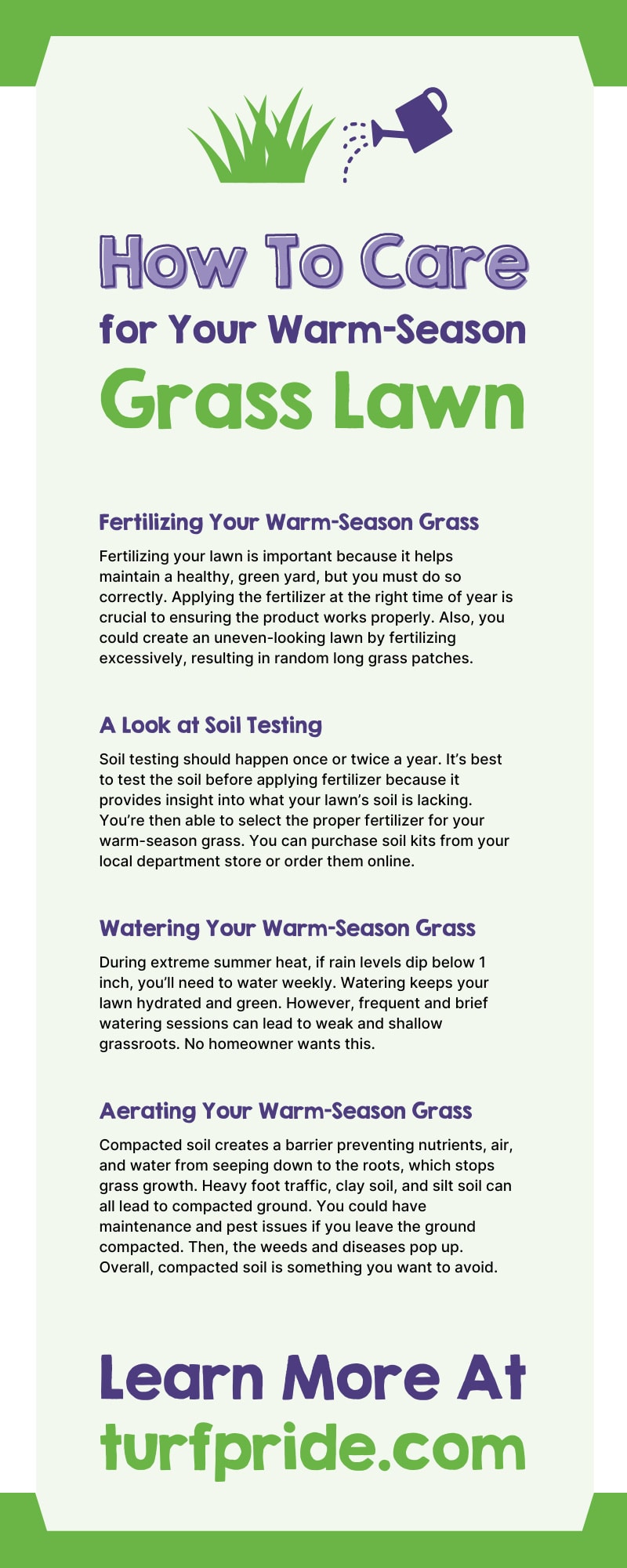Following the correct maintenance is essential to have a beautiful and healthy-looking yard. Many homeowners understand how to mow their yards, but their knowledge of yard maintenance doesn’t go much further. Following a schedule will ensure your property remains luscious, healthy, and green during the growing season.
However, the proper care depends on the kind of grass you have. Warm-season grasses grow in the southern region of the United States. If you have a warm-season grass lawn, you’ll find a closer look at how to care for it below.
What Are Warm-Seasons Grasses?
There are two major lawn grass groups: warm-season and cool-season. This blog will focus on the former. Warm-season grasses include the following:
- St. Augustine grass
- Bahia grass
- Centipede grass
- Bermuda grass
- Zoysia grass
- Carpet grass
Specialists refer to this group as the Southern grasses. They grow best in the heat of the South and tropical regions because they can’t handle harsh winter conditions. Warm-season grasses lack the hardiness that cool-season grasses have. These grass types love the heat and will grow best in temperatures between 75 and 90 degrees.
Depending on where in the South you live, warm-season lawns can grow actively from mid-spring through summer. If you live further south, this grass could thrive into the fall. However, warm-season grass goes dormant and brown during the winter, and you won’t see it again until the weather begins to warm in the spring.
Keep in mind that not all warm-season grasses thrive in exactly the same environment. For example, Bermuda and zoysia grasses like to live in the transition zone. What’s the transition zone? It’s an overlap area where warm-season and cool-season grasses can both grow well. Therefore, zoysia and Bermuda can handle winter better than other warm-season lawns.
On the other hand, St. Augustine and bahia grasses love sandy soil and salty air. Therefore, Southern California is the perfect place to grow St. Augustine grass. Both grass types grow well along the Southern Atlantic and Gulf coastline.
Finally, you’ll primarily find centipede grass in the Southeast. It’s an incredibly popular, low-maintenance lawn option.
Fertilizing Your Warm-Season Grass
Fertilizing your lawn is important because it helps maintain a healthy, green yard, but you must do so correctly. Applying the fertilizer at the right time of year is crucial to ensuring the product works properly. Also, you could create an uneven-looking lawn by fertilizing excessively, resulting in random long grass patches. Be careful with under-fertilization too. You could have a sparse-looking lawn that allows weeds to take over and diseases to develop. And no homeowner wants a weedy lawn!
Use a lawn care company, like TurfPride, to develop a fertilization plan. We’ll sample your soil to determine the lacking nutrients in your yard. Then, based on your soil analysis, we’ll apply fertilizer two to four times a year during the appropriate seasons.
A Look at Soil Testing
We just mentioned soil testing, but let’s further examine this important aspect of warm-season grass care. Soil testing should happen once or twice a year. It’s best to test the soil before applying fertilizer because it provides insight into what your lawn’s soil is lacking. You’re then able to select the proper fertilizer for your warm-season grass.
You can purchase soil kits from your local department store or order them online. Another option, as we mentioned, is to call TurfPride to perform the analysis for you. Our experienced lawn technicians will use the collected information to develop a plan to help your warm-season grass lawn thrive.
But what information will you gather from a soil test? You’ll discover your lawn’s levels of the following nutrients:
- Potassium
- Nitrogen
- Phosphorous
- pH Level
- Other micronutrients
If you’re going to perform one soil test, ensure you conduct it in the fall. The conditions are typically dry, and you need dry soil for the analysis. You can also perform a test during the springtime. You just want to ensure any resulting soil corrections have time to begin working before the growing season.
Soil pH
If the soil test concludes your lawn’s pH level is out of optimal range, you can correct it with modifications like sulfur and lime. Your warm-season grasses won’t absorb the nutrients and fertilizer you’re laying down if the pH levels are off. May through August are the ideal months to apply lime and sulfur.
Watering Your Warm-Season Grass
The South can experience droughts, which isn’t great for grass. But one of the reasons warm-season grasses grow well in this climate is because they’re drought tolerant. However, that doesn’t mean your warm-season grass lawn won’t need watering.
During extreme summer heat, if rain levels dip below 1 inch, you’ll need to water weekly. Watering keeps your lawn hydrated and green. However, frequent and brief watering sessions can lead to weak and shallow grassroots. No homeowner wants this. Follow these tips to water your lawn efficiently:
- Longer and infrequent watering sessions allow roots to grow deep.
- Water early in the morning; otherwise, the sun will zap the moisture.
- Ensure grass blades are dry before humidity rises. Lawn diseases are a risk if you don’t.
- Experts advise not to allow more than 1 inch of water per watering session.
- Only consider watering your yard when you get less than an inch of rain in a week.
Aerating Your Warm-Season Grass
Compacted soil creates a barrier preventing nutrients, air, and water from seeping down to the roots, which stops grass growth. Heavy foot traffic, clay soil, and silt soil can all lead to compacted ground. You could have maintenance and pest issues if you leave the ground compacted. Then, the weeds and diseases pop up. Overall, compacted soil is something you want to avoid.
Aeration is the best method to break up the soil. Hire a professional lawn care service to aerate your property, relieving your lawn of any compaction. Aerate your lawn once or twice a year during spring or summer. The extra moisture sitting on the grass is ideal for the aeration process.
Covering Weed Control
Weeds steal nutrients and water from grass, so you don’t want them in your yard. They can create a thin, bare-looking lawn. You can try to cover the weed control yourself, but hiring professionals is the most efficient means. Working with a lawn care team will ensure quality fertilizing, weeding, pest control, and additional services.
Now that you understand how to care for your warm-season grass lawn, you’ll be able to enjoy your yard all season. You can say goodbye to thin, bare patches and effectively remove weeds from your property. And remember—don’t be afraid to use professional services. TurfPride is a trustworthy and reliable lawn service company that will properly care for your yard and provide you with attentive, quality customer service. Contact us today for more information; we’d love to hear from you!


